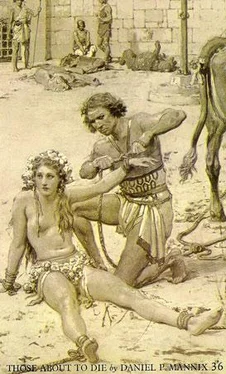Daniel Mannix - Those About to Die
Здесь есть возможность читать онлайн «Daniel Mannix - Those About to Die» весь текст электронной книги совершенно бесплатно (целиком полную версию без сокращений). В некоторых случаях можно слушать аудио, скачать через торрент в формате fb2 и присутствует краткое содержание. Год выпуска: 1972, ISBN: 1972, Издательство: Mayflower Books Ltd, Жанр: Исторические приключения, на английском языке. Описание произведения, (предисловие) а так же отзывы посетителей доступны на портале библиотеки ЛибКат.
- Название:Those About to Die
- Автор:
- Издательство:Mayflower Books Ltd
- Жанр:
- Год:1972
- ISBN:978-0583121347
- Рейтинг книги:4 / 5. Голосов: 1
-
Избранное:Добавить в избранное
- Отзывы:
-
Ваша оценка:
- 80
- 1
- 2
- 3
- 4
- 5
Those About to Die: краткое содержание, описание и аннотация
Предлагаем к чтению аннотацию, описание, краткое содержание или предисловие (зависит от того, что написал сам автор книги «Those About to Die»). Если вы не нашли необходимую информацию о книге — напишите в комментариях, мы постараемся отыскать её.
Those About to Die — читать онлайн бесплатно полную книгу (весь текст) целиком
Ниже представлен текст книги, разбитый по страницам. Система сохранения места последней прочитанной страницы, позволяет с удобством читать онлайн бесплатно книгу «Those About to Die», без необходимости каждый раз заново искать на чём Вы остановились. Поставьте закладку, и сможете в любой момент перейти на страницу, на которой закончили чтение.
Интервал:
Закладка:
The boy went through the usual course at the school and learned many things which his rough-and-ready, rule-of-thumb education as cageboy in the arena had not taught him. As with gladiators, there were many types of bestiarii: men who specialized in keeping ahead of the beasts by rurming, men who learned how to dodge them, bull-fighters, lion-tamers, pole-vaulters, and so on. Carpophorus, because of his great strength and brutal technique, was made a venator— a hunter. He learned how to fight wild animals barehanded, strangling them or breaking their necks. He learned how to blind a lioness by throwing a cape over her head and then cracking her back by striking the loins with the edge of his hand. (At least, the Roman writers claim that bestiarii could do this—it must have been quite a trick.) He also fought bears with a veil in one hand to distract the animal and a sword in the other.
To learn how to dodge, the young man was sent out against a leopard tied to a bull by a long rope. As the bull could move as well as the leopard, this was a far tougher job than if the cat were simply tied to a stake but much easier than if the leopard were free. Another bestiarius with a spear stood behind the animals, goading them on. Carpophorus was also exposed to two wild animals at the same time, such as a lion and a leopard, and had to learn to avoid both. He was sometimes forced to lie on the ground while a wild boar or bull was set on him. Carpophorus had to learn how to leap to his feet at the last instant to escape the rush. He had to learn how to irritate wild animals by allowing them almost to catch him and then vaulting over a low fence or behind a wooden shield (as in modern bull-fights). The purpose of this manoeuvre was to make the animals so furious that they would willingly attack the condemned criminals afterwards thrown to them.
Naturally, Carpophorus was soon covered with scars, but like all bestiarii he was as proud of his scars as a soldier is of his medals, considering them a hallmark of his profession. You could point to any scar and Carpophorus could tell you when and how he had received it.
The young bestiarius had two serious vices: he was a heavy drinker and had a berserk temper. Wine was forbidden the students, except during meals, and then mixed with water, but Carpophorus knew his way around and managed to get his own supply. One of his jobs in the school was to train a leopard to be a man-eater. This was a complicated process as none of the big cats willingly attacks humans. The first part of the training consisted in overcoming the leopard's instinctive dread of human beings. For this purpose, a leopard born in captivity who had never learned to fear people was far preferable to a wild caught animal. A particularly mean, half-grown cub was selected and a bestiarius, heavily padded, approached the animal deliberately pretending to be nervous. As soon as the leopard made a swipe at him, the bestiarius fell on the cage floor, rolling in apparent agony. The sight of a prostrate victim will generally encourage any aggressive animal to attack and also the man had bits of meat tied to his padding. In this way, the leopard was taught to be a killer. The animal always won in these combats and the trainer was careful never to strike or discipline him in any manner whatever.
The leopard was always fed human meat—there was plenty of that around the arena—and later encouraged to attack slaves. These men had their arms broken and teeth knocked out so they could not injure the animal. A desperate man can kill a leopard with his bare hands (Carl Akeley, the African explorer, accomplished this feat) but even if women or children were used the animal had to be convinced that he could always win without trouble. Finally, when the animal was completely confident of his powers, he was given uncrippled slaves to kill. If the slave put up too much of a struggle, the watching bestiarius helped the leopard out by a quick spear thrust.
Carpophorus' man-eater was a perfectly trained animal. He had developed such a perfect "habit pattern" that he never thought of attacking Carpophorus or anyone except a person exposed on the sand of the training arena. He was used to eating only under these specific conditions and would have starved to death in a butcher shop because he wouldn't have recognized the meat as edible. (This may seem incredible but it's true. A confirmed man-eating lion or tiger will charge through a herd of sheep to get at the shepherd and will not touch a freshly killed cow because he has lost his taste for anything but human flesh. This was true of the famous man-eaters of Tsavo in Kenya, East Africa, who held up the construction of a railroad for three weeks. These two lions ignored goats, cattle and even zebra—the lions' favourite food —left out for them. They finally had to be lured into a double-compartmented trap with two men in one of the compartments. Even with a fusillade of bullets whining about them, they continued to try to reach the men.)
Carpophorus' leopard had become so fixed in this "habit pattern" that the young bestiarius could take him for walks past the antelope herds in the big stockyards where animals intended for the arena were kept. The leopard paid no attention to the antelopes. However, for safety's sake Carpophorus always took him on a leash until one evening when Carpophorus had a little too much wine and he didn't bother to leash the leopard while taking the animal down to drink. By bad luck, something panicked the antelopes and they rushed past the leopard. The sight of the fleeing animals so close to him awoke the big cat's hunting instinct and he sprang on an oryx. Carpophorus tried to drag him off but the leopard clung to the terrified antelope, hanging to the oryx's flank with his long dewclaws. In a blind fury, Carpophorus brought his flail with the lead balls down on the leopard's head and killed him with a single blow.
The young man had killed an animal far more valuable than himself and the raging instructor of the school, to whom Carpophorus had pledged himself as a slave, ordered him thrown to the wild beasts at the next show. Carpophores accepted his fate in grim silence. But the beasts used to be as executioners were all animals from the stockyards and Carpophorus knew them well. When he was driven into the arena by the circus slaves, Carpophorus strode up to the mixed group of lions, tigers, leopards and bears shouting, "You, Cheops! You, Lesbia! Down, Herod! Good girl, Cypros!" The puzzled animals slunk away and started fighting among themselves. This exhibition so impressed the crowd that they demanded Carpophorus' release and he was sent back to the school. After that, he never again touched wine when working with an animal and made a serious attempt to control his temper.
When Carpophorus graduated from the school, he became a working bestiarius in the arena. Unlike most of his fellows, Carpophorus never lost sight of the fact that his basic job was to please the crowd, not perform some remarkable feat that could only be appreciated by other bestiarii or a few of the connoisseurs on the podium. Having grown up "under the stands" he knew that it was the mob who ran the circus, not the highbrows in the front seats and far less was it the old-time bestiarii who used to meet in the evenings at Chilo's wine shop off the Via Appia and talk of their past triumphs while the respectful younger men sat around and listened. For example, these old-timers considered it a great feat to train stags to pull a chariot. Stags are very nervous animals and only a few bestiarii had ever managed to accomplish this stunt; in Egypt, the animal trainers of Ptolemy had trained stags to pull their royal master, and in Greece, a priestess had appeared in a coach drawn by these dramatic beasts. It was every bestiarius' ambition to duplicate this feat—everyone except Carpophorus. He knew that the public cared nothing about such a stunt, difficult though it might be. They'd just as soon see a chariot drawn by zebras or ostriches which was comparatively easy to do. As a matter of fact, they weren't particularly interested in seeing a chariot drawn by any sort of freak animal. They wanted stronger fare. Carpophorus determined to give it to them.
Читать дальшеИнтервал:
Закладка:
Похожие книги на «Those About to Die»
Представляем Вашему вниманию похожие книги на «Those About to Die» списком для выбора. Мы отобрали схожую по названию и смыслу литературу в надежде предоставить читателям больше вариантов отыскать новые, интересные, ещё непрочитанные произведения.
Обсуждение, отзывы о книге «Those About to Die» и просто собственные мнения читателей. Оставьте ваши комментарии, напишите, что Вы думаете о произведении, его смысле или главных героях. Укажите что конкретно понравилось, а что нет, и почему Вы так считаете.












